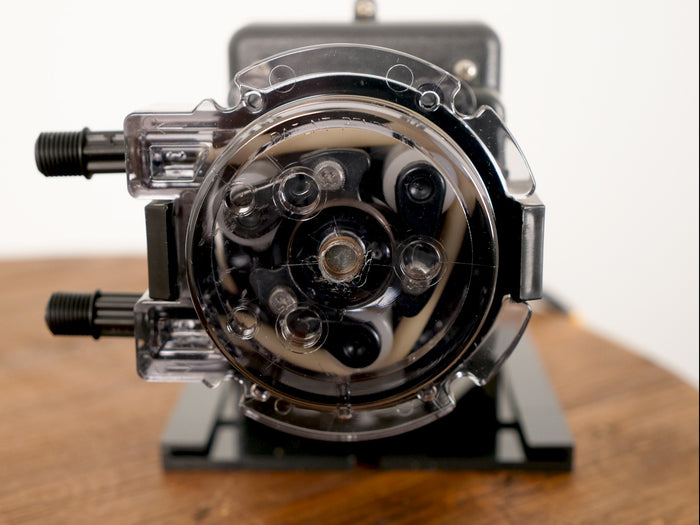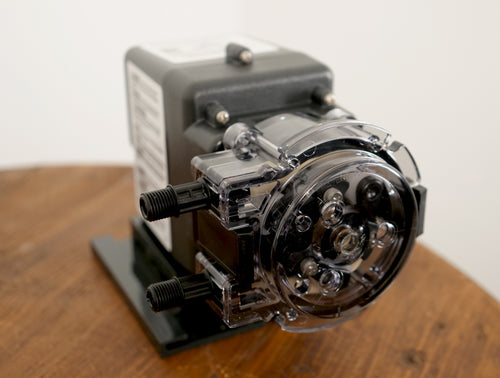Many types of pumps can transport clean liquids, but many of these are unable to handle fluids with debris. Peristaltic pumps are designed to tackle the liquids that other pumps cannot. Toxic chemicals, slurry, and wastewater present problems with many pump types, such as centrifugal pumps, but they can easily be handled by the no-contact design of peristaltic pumps. In this article, you can find information about what peristaltic pumps are, how they work, the types of peristaltic pumps, what maintaining these pumps looks like, and their advantages and disadvantages.
Table of Contents
What is a peristaltic pump?How does a peristaltic pump work?What are peristaltic pumps used for?Advantages of peristaltic pumpsDisadvantages of peristaltic pumpsTypes of peristaltic pumpsTypes of peristaltic pump rollersHow to maintain a peristaltic pumpHow much do peristaltic pumps cost?How long do peristaltic pumps last?What is a peristaltic pump?
A peristaltic pump, also known as a roller pump, is a rotary positive displacement pump that can move fluids of many viscosities through a hose. Because they use a hose, peristaltic pumps transport liquids without the contents coming into contact with the pump components. From the pump’s intake to the point of discharge, liquid flowing through a peristaltic pump only contacts the pump’s tubing. This means peristaltic pumps airtight systems that are protected from drips and leaks. This attribute is essential in these pumps because they are commonly used with toxic chemicals. The seals, O-rings, valves, and other components of peristaltic pumps do not need to be tested for chemical compatibility. Rather, only the pump’s tubing must be suited to withstand the harsh effects of the chemicals being pumped.
How does a peristaltic pump work?
Peristaltic pumps transport fluid by continuously compressing a hose with a set of rotating rollers. These rollers, also called shoes, create a vacuum through rotary motion to draw liquid into the pump. Once the water has entered the hose, a second shoe pushes the liquid around the pump to the outlet. The next roller then squeezes an empty portion of the hose, creating a vacuum that draws liquid in, and the cycle continues. The more rollers a peristaltic pump possesses, the more constant its flow. Pumps with only two rollers will pump with noticeable intervals between discharges. This flow variation is known as pulsation, and it can be mitigated by utilizing more rollers inside the pump casing.
Peristaltic pumps are extremely effective at pumping thick fluids and liquids with particulate matter. Most pumps contain check valves that prevent backflow, the backing up of liquid into the pump’s inlet. The roller design of peristaltic pumps makes them inherently immune to backflow. These pumps are a one-way system. The rollers only rotate in one direction, meaning the suction they create can only bring liquid in from the outside and not the other way around. The check valves used in other pump types prevent backflow, but they are susceptible to clogging from particulate matter. Because peristaltic pumps do not need any check valves, there are not any components that particulates can cling to and cause problems.
Variations in peristaltic pump design
Variations in the designs of peristaltic pumps are influenced by the tubing thickness, the number and type of rollers in the pump, and the number of channels the pump uses. Thick tubing, for example, requires greater pressure to squeeze than thin tubing, so a pump’s rollers must be equipped to handle thick tubing in high-pressure applications. The type and number of rollers a peristaltic pump possesses impacts the applications the pump can be used for and the longevity of the tubing.
What are peristaltic pumps used for?
Peristaltic pumps are used in a wide variety of applications in multiple fields. The best feature of these pumps is their ability to keep chemicals and liquids strictly in the tube. Peristaltic pumps are commonly used in the following applications:
- Transporting hemoglobin for dialysis
- Surgeries
- Water treatment dosing (depending on the chemical used)
- Chlorine for a private well
- Liquid phosphate for scale control
- As a flocculant (depending on the type of water treatment)
- Dosing vitamins into animal feed
- Agriculture
Uses for a peristaltic pump include any application where you want to ensure you have no-cross contamination of your nutrient, chemical, or even blood in the case of dialysis.
Advantages of peristaltic pumps
Peristaltic pumps are useful for many applications because of their many advantages over other pumps.
- Resistant to leaks
- Capable of running dry for extended periods
- Can handle very viscous and rough fluids (up to 60,000 cps)
- Do not allow contamination
- Resistant to backflow
- Useful in a variety of applications
- Cost little to maintain
Disadvantages of peristaltic pumps
While peristaltic pumps are excellent for many applications, they do possess a few disadvantages when compared to other pump types.
- High initial cost
- Tubing degrades with each use
- Higher power usage than most pumps
- Causes pulsation in flowrate
Learn more about other pump types: Permeate pumps | Bilge pumps | Well pumps | Booster pumps

Types of peristaltic pumps
Peristaltic pumps are categorized into two types: hose and tube pumps. Both pump types utilize rollers to transport fluid within a tube, but they differ in their pressure capabilities, tubing material, and heat dissipation.
Peristaltic hose pumps
Hose peristaltic pumps are used in industrial applications because they contain thick reinforced tubes to transport fluids through the pump. Because of these thick tubes, hose pumps can operate at pressures up to four times greater than tube pumps can. Greater operating pressure also means that hose peristaltic pumps do not experience blockages as often as their tube counterparts. Unlike tube pumps, hose pumps contain casings filled with lubricant to prevent overheating and abrasion due to friction caused by the rollers.
Peristaltic tube pumps
Tube peristaltic pumps move liquid at lower pressures than hose pumps. Instead of a thick reinforced tube, the rollers inside a tube roller pump squeeze a thin, non-reinforced tube. The number of rollers a tube pump contains can range anywhere from two to twelve. Regardless of number, these rollers are always positioned equidistant from each other. For example, two rollers will be positioned 180 degrees apart, while four rollers will be located 90 degrees from each other. Pumps with two rollers discharge fluid with lower frequency than those with more. However, pumps with a high number of rollers will live shorter lifespans than those with a few due to increased blockages in the tube. The most common applications of these low-pressure pumps are medical liquids and chemical metering.
Types of peristaltic pump rollers
Peristaltic pumps have one of two types of rollers: fixed occlusion and spring loaded.
Fixed occlusion rollers
Fixed occlusion rollers do not change position at any time. They have a fixed position and rotation, causing the pressure they place on the tubing to be constant. Thick tubing is less compatible with fixed occlusion rollers than thin tubing. This incompatibility is the result of blockages, also called occlusions, that occur in between cycles of a peristaltic pump. The thicker the tubing, the less pressure a fixed occlusion roller applies. This causes occlusion to be greater and, as a result, shortens the lifespan of the tubing. To combat this problem, ensure that the thickness of the tubing you select is compatible with your pump.
Spring-loaded rollers
Spring-loaded rollers, as the name suggests, are controlled by a spring. These rollers exert a force on the tubing that correlates with the tubing thickness. With spring-loaded rollers, the pressure the tubing experiences is constant regardless of its thickness and size. Thick tubing is used with high-pressure pumps, so spring-loaded rollers are more common in hose peristaltic pumps than their tube counterparts.
How to maintain a peristaltic pump
Peristaltic pumps are one of the lowest maintenance pump types because the pump components do not contact the liquid being pumped. The main maintenance a peristaltic pump requires is the monitoring and replacement of tubing. Roller pumps exert constant pressure on the tubing, causing it to deteriorate over time. As the tubing wears down, the feed rate of the pump diminishes. When this occurs, more power is used by the pump than when the tubing is in optimal condition. When the tubing begins affecting the pump’s performance, it should be replaced.
Peristaltic pump tubing is rated by how many hours it can last under full stress. When using a peristaltic pump, the operator should document the number of hours that the tubing has been utilized. Once the tubing reaches the rated timeframe, it should be replaced. The lifespan of tubing is also affected by the pump it is being used with. Ensure that the tubing thickness and size are compatible with the pump you are using. If the tubing is too thin for a specific pump, the rollers may apply too much pressure and cause it to break. If the tubing is too thick, the rollers may apply too little pressure and cause damaging occlusion within the system.
How to clean a peristaltic pump
Because peristaltic pumps do not contact the fluids they pump, their tubing must be cleaned more frequently than the pump itself. If sticky liquids are used with the pump, the tubing must be cleaned regularly to ensure that it remains free of obstructions. To clean the tubing in a peristaltic pump, simply replace the normal fluid with soap and follow it up a sanitizing solution, such as an isopropyl alcohol. Allow the tube to dry before resuming normal operations. The exterior of a peristaltic pump may not get dirty often, but it is wise to regularly wipe down the outside surfaces with an isopropyl alcohol solution. Before wiping these surfaces, switch the pump off and unplug the power source. Allow the pump to dry before returning power.
How much do peristaltic pumps cost?
A commercial peristaltic pump will likely cost you between $250 to $1000 per line. These pumps have a higher initial cost than many other pump types. However, the only maintenance cost associated with them is tube replacement, a relatively inexpensive process.
How long do peristaltic pumps last?
The motors of peristaltic pumps can last for several thousand hours; some can even last up to 10,000 hours. The long lifespan of peristaltic pumps is due in large part to their no-contact pumping design. Rather than the pump taking damage from abrasive liquids, the tubing bears the brunt of the damage from particulates and debris in liquids.
If you have any additional questions, please do not hesitate to contact us.

My wife and I are looking into peristaltic pumps for the installation of our well in the new house. We decided to look it up and fortunately for us, we stumbled on your amazing article. Personally, I liked how you mentioned the benefits of a peristaltic pump. I am sure many like us can agree on wanting to avoid any cross contamination with this pump. Thank you so much for this!